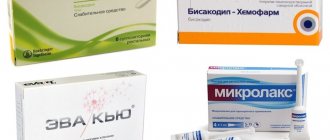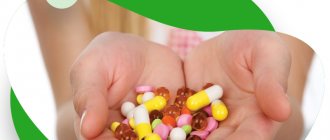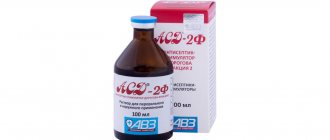Composition and release form
Fervex
| Powder for solution for oral administration, raspberry with sugar | 1 pack |
| paracetamol | 500 mg |
| ascorbic acid | 200 mg |
| pheniramine maleate | 25 mg |
| excipients: sucrose; anhydrous citric acid; acacia gum (gum acacia); sodium saccharinate; raspberry flavor |
in sachets of combined material, 13.1 g; There are 8 sachets in a cardboard pack.
| Powder for oral solution, lemon with sugar | 1 pack |
| paracetamol | 500 mg |
| ascorbic acid | 200 mg |
| pheniramine maleate | 25 mg |
| excipients: sucrose; anhydrous citric acid; gum arabic; soluble saccharin; lemon rum flavoring (Antilles) |
in sachets of combined material, 13.1 g; There are 8 sachets in a cardboard pack.
| Powder for preparing a solution for oral administration, lemon without sugar | 1 pack |
| paracetamol | 500 mg |
| ascorbic acid | 200 mg |
| pheniramine maleate | 25 mg |
| excipients: mannitol; anhydrous citric acid; povidone; trimagnesium dicitrate anhydrous; aspartame; lemon rum flavoring (Antilles) |
in sachets of combined material, 4.95 g; There are 8 sachets in a cardboard pack.
Fervex for children
| Powder for solution for oral administration | 1 pack |
| paracetamol | 280 mg |
| pheniramine maleate | 10 mg |
| ascorbic acid | 100 mg |
| excipients: sucrose; riboflavin sodium phosphate; magnesium citrate; aspartame; banana-caramel flavoring* | |
| *flavor composition: base: maltodextrin, acacia gum, sorbitol - up to 100%; aromatic components: isoamyl acetate, isoamyl isovalerate - less than 5%; ethyl butyrate, geranyl formate, citral, vanillin, ethyl vanillin, butyl butyryllactate, dihydrocoumarin - less than 1% |
in sachets of 3 g; There are 8 sachets in a cardboard pack.
What is Fervex?
The drug Fervex is a dry powder for preparing a solution, which includes:
- Paracetamol is an antipyretic, analgesic and anti-inflammatory agent.
- Ascorbic acid or vitamin C is a supplement that strengthens the walls of blood vessels and improves immunity.
- Pheniramine is an antihistamine (antiallergic) component.
The main substance in the drug is paracetamol, the action of which does not pose a danger to the developing fetus from a certain stage of development.
It can be argued that Fervex is a mixture of regular paracetamol and ascorbic acid in powder, packaged in bright packaging.
Pheniramine has antiallergic properties, eliminates nasal congestion and itching, but it does not cure, but blocks severe symptoms. Doctors do not have reliable information about the safety of Fervex during pregnancy, so you should not use it often.
Description of the dosage form
Fervex
Raspberry with sugar: light pink to light beige powder. Blotches of dark pink color are allowed.
Lemon with sugar: light beige powder with a characteristic odor. Brown inclusions are allowed.
Lemon without sugar: light beige powder with a characteristic odor. Brown inclusions are allowed.
Fervex for children
Powder of light yellow color interspersed with yellow color with a characteristic odor.
Pharmacodynamics
Combined drug.
Paracetamol has an analgesic and antipyretic effect, which is associated with its effect on the thermoregulation center in the hypothalamus; eliminates headaches and other types of pain, reduces fever.
Ascorbic acid (vitamin C) is involved in the regulation of redox processes, carbohydrate metabolism, blood clotting, tissue regeneration, synthesis of corticosteroids, collagen and procollagen; normalizes capillary permeability. Increases the body's resistance, which is associated with stimulation of the immune system.
Pheniramine - a blocker of H1-histamine receptors - reduces rhinorrhea, nasal congestion, sneezing, lacrimation, itching and redness of the eyes.
Pharmacokinetics
Fervex for children
Paracetamol. Absorption of paracetamol is complete and rapid. Peak plasma concentrations are reached 30–60 minutes after administration. The distribution of paracetamol in tissues occurs quickly. Comparable drug concentrations are achieved in blood, saliva and plasma. Plasma protein binding is low, 10–25%. Penetrates through the BBB.
Metabolism occurs in the liver, 80% enters into conjugation reactions with glucuronic acid and sulfates to form inactive metabolites; 17% undergoes hydroxylation to form 8 active metabolites, which conjugate with glutathione to form inactive metabolites. With a lack of glutathione, these metabolites can block the enzyme systems of hepatocytes and cause their necrosis. The CYP2E1 isoenzyme is also involved in the metabolism of the drug. T1/2 - 1-4 hours. Excreted by the kidneys in the form of metabolites, mainly conjugated. Less than 5% is excreted unchanged.
Pheniramine maleate. Well absorbed in the digestive tract. T1/2 from blood plasma is 1–1.5 hours. It is excreted from the body mainly through the kidneys.
Ascorbic acid. Well absorbed in the digestive tract. Tmax after oral administration is 4 hours. Metabolized mainly in the liver. It is excreted by the kidneys, through the intestines, with sweat - unchanged and in the form of metabolites.
Side effects
Fervex
Fervex for children
The drugs are well tolerated in recommended doses.
Nausea, pain in the epigastric region, allergic reactions (skin rash, itching, urticaria, Quincke's edema).
Rarely - hematopoietic disorders (anemia, thrombocytopenia, methemoglobinemia), dry mouth, accommodation paresis, urinary retention, drowsiness. With long-term use (in doses significantly higher than recommended), the likelihood of liver and kidney dysfunction increases; monitoring of the peripheral blood picture is necessary. All side effects of the drug should be reported to your doctor. If adverse reactions occur, you should stop taking the drug and consult a doctor.
When the drug is contraindicated
Fervex, like any other drug, has a number of contraindications. If you take it in recommended dosages, there will be no side effects. In case of overdose, renal dysfunction, chronic fatigue and drowsiness are possible.
In addition, Fervex cannot be combined with its analogues - drugs based on paracetamol. Other contraindications include:
- Chronic diseases of the gastrointestinal tract;
- Hepatitis, liver cirrhosis, pyelonephritis;
- Allergic reactions.
Interaction
Fervex
Ethanol enhances the sedative effect of antihistamines.
Antidepressants, antiparkinsonian drugs, antipsychotic drugs (phenothiazine derivatives) increase the risk of side effects (urinary retention, dry mouth, constipation). GCS increase the risk of developing glaucoma.
Inducers of microsomal oxidation in the liver (phenytoin, ethanol, barbiturates, rifampicin, phenylbutazone, tricyclic antidepressants) increase the production of hydroxylated active metabolites, which makes it possible to develop severe intoxications with small overdoses. Ethanol contributes to the development of acute pancreatitis.
Inhibitors of microsomal oxidation (including cimetidine) reduce the risk of hepatotoxicity. Paracetamol reduces the effectiveness of uricosuric drugs.
Fervex for children
Due to its constituent pheniramine, it enhances the effect of sedatives, and when used together with antipsychotics (phenothiazine derivatives), it increases the risk of developing side effects of the drug (urinary retention, dry mouth, constipation).
The possibility of enhancing central atropine-like effects should be taken into account when used in combination with other substances with anticholinergic properties (other antihistamines, imipramine antidepressants, phenothiazine neuroleptics, anticholinergic antiparkinsonian drugs, atropine-like antispasmodics, disopyramide). When using the drug together with barbiturates, tricyclic antidepressants, anticonvulsants (phenytoin), flumecinol, phenylbutazone, rifampicin and ethanol, the risk of hepatotoxicity (due to paracetamol included in the composition) significantly increases. Concomitant use with salicylates increases the risk of nephrotoxicity. When used simultaneously with chloramphenicol (chloramphenicol), the toxicity of the latter increases.
Paracetamol contained in the drug enhances the effect of indirect anticoagulants and reduces the effectiveness of uricosuric drugs.
Fervex®
Ethanol enhances the sedative effect of antihistamines (pheniramine), so its use should be avoided during treatment with Fervex®. In addition, ethanol, when used simultaneously with pheniramine, contributes to the development of acute pancreatitis,
Pheniramine in Fervex® enhances the effect of sedatives: morphine derivatives, barbiturates, benzodiazepines and other tranquilizers, neuroleptics (meprobamate, phenothiazine derivatives), antidepressants (amitriptyline, mirtazapine, mianserin), centrally acting antihypertensive drugs, sedatives belonging to the H1 group - blockers, baclofen; this not only increases the sedative effect, but also increases the risk of developing side effects of the drug (urinary retention, dry mouth, constipation).
The possibility of enhancing central atropine-like effects should be taken into account when used in combination with other substances with anticholinergic properties (other antihistamines, imipramine antidepressants, phenothiazine neuroleptics, m-anticholinergic antiparkinsonian drugs, atropine-like antispasmodics, disopyramide).
When using the drug together with inducers of microsomal oxidation: barbiturates, tricyclic antidepressants, anticonvulsants (phenytoin), flumecinol, phenylbutazone, rifampicin and ethanol, the risk of hepatotoxicity increases significantly (due to paracetamol included in the composition).
Glucocorticosteroids, when used simultaneously, increase the risk of developing glaucoma.
Concomitant use with salicylates increases the risk of nephrotoxicity.
When used simultaneously with chloramphenicol (chloramphenicol), the toxicity of the latter increases.
Paracetamol contained in the drug enhances the effect of indirect anticoagulants and reduces the effectiveness of uricosuric drugs.
Ascorbic acid increases the concentration of benzylpsnicillin and tetracyclines in the blood; at a dose of 1 g/day increases the bioavailability of ethinyl estradiol (including that included in oral contraceptives).
Improves the absorption of iron preparations in the intestines (converts ferric iron to divalent iron); may increase iron excretion when used concomitantly with deferoxamine.
Reduces the effectiveness of heparin and indirect anticoagulants.
When used simultaneously with acetylsalicylic acid (ASA), the urinary excretion of ascorbic acid increases and the excretion of ASA decreases. ASA reduces the absorption of ascorbic acid by approximately 30%.
Increases the risk of developing crystalluria during treatment with salicylates and short-acting sulfonamides, slows down the excretion of acids by the kidneys, increases the excretion of drugs that have an alkaline reaction (including alkaloids), and reduces the concentration of oral contraceptives in the blood.
Increases the overall clearance of ethanol, which in turn reduces the concentration of ascorbic acid in the body.
Quinoline drugs, calcium chloride, salicylates, and glucocorticosteroids deplete ascorbic acid reserves when used for a long time.
When used simultaneously, ascorbic acid reduces the chronotropic effect of isoprenaline.
With long-term use or use in high doses, it may interfere with the interaction of disulfiram and ethanol. In high doses, it increases the excretion of mexiletine by the kidneys.
Barbiturates and primidone increase the excretion of ascorbic acid in the urine.
Reduces the therapeutic effect of neuroleptics - phenothiazine derivatives, tubular reabsorption of amphetamine and tricyclic antidepressants.
Directions for use and doses
Fervex
Inside, completely dissolve in a glass (200 ml) of warm water (50–60 °C), drink the resulting solution immediately. It is better to take the drug between meals.
1 sachet 2-3 times a day. The interval between doses of the drug should be at least 4 hours. In patients with impaired liver or kidney function and in elderly patients, the interval between doses of the drug should be at least 8 hours.
The duration of use without consulting a doctor is no more than 5 days when prescribed as an analgesic and no more than 3 days when prescribed as an antipyretic.
Fervex for children
Take inside, after dissolving the contents of the sachet in a glass (200 ml) of warm water.
Depending on the age of the child, the drug is used in the following doses: children 6–10 years old - 1 sachet 2 times a day; 10–12 years - 1 sachet 3 times a day; 12–15 years old - 1 sachet 4 times a day.
The interval between doses of the drug should be at least 4 hours. The duration of treatment is no more than 3 days.
Recommended dosage
The manufacturer produces 2 versions of the drug: with and without sugar (for patients with diabetes). The finished solution is very aromatic with a pleasant taste of lemon, orange or raspberry.
It is recommended to dissolve the powder in warm, but not hot water. You should drink it no more than 3 times a day with breaks of 4-5 hours.
If a pregnant woman does not have a high temperature (38+), a fruit drink will help reduce the fever; linden tea with honey, lemon juice, raspberry jam or other herbal teas will maintain strength until an appointment with an obstetrician-gynecologist.
Overdose
Fervex
Symptoms of overdose caused by paracetamol: pale skin, loss of appetite, nausea, vomiting; hepatonecrosis (the severity of necrosis due to intoxication directly depends on the degree of overdose). Toxic effects in adults are possible after taking more than 10–15 g of paracetamol: increased activity of liver transaminases, increased PT (12–48 hours after administration); a detailed clinical picture of liver damage appears after 1–6 days. Rarely, liver failure develops rapidly and can be complicated by renal failure (tubular necrosis).
Treatment: in the first 6 hours after an overdose, gastric lavage, administration of SH-group donors and precursors for the synthesis of glutathione - methionine 8-9 hours after an overdose and N-acetylcysteine after 12 hours. The need for additional therapeutic measures (further administration of methionine, i.v. in the administration of N-acetylcysteine) is determined by the concentration of paracetamol in the blood, as well as the time elapsed after its administration.
Fervex for children
Symptoms of acute paracetamol poisoning: anorexia, nausea, vomiting, epigastric pain, sweating, pale skin, drowsiness. After 1–2 days, signs of liver damage appear. In severe cases, liver failure, hepatonecrosis, encephalopathy and coma develop.
Treatment: Stop using the drug and consult a doctor immediately. Gastric lavage, administration of enterosorbents (activated carbon, hydrolytic lignin), intravenous administration of the antidote acetylcysteine, and administration of methionine are recommended.
special instructions
Fervex
If you are taking metoclopramide, domperidone or cholestyramine, you should also consult your doctor.
It is possible to distort laboratory test results when quantifying the concentration of uric acid and glucose in plasma. To avoid toxic liver damage, paracetamol should not be combined with alcoholic beverages, or taken by persons prone to chronic alcohol consumption. The risk of developing liver damage increases in patients with alcoholic hepatosis.
If the drug is taken by patients suffering from diabetes or on a low-sugar diet, it should be taken into account that each sachet contains 11.5 g of sugar, which corresponds to 0.9 XE.
Additionally for Fervex lemon without sugar: the drug does not contain sugar and can be used by patients suffering from diabetes.
Fervex for children
The drug should not be used simultaneously with other medications containing paracetamol.
When using the drug for more than a week, monitoring the functional state of the liver and peripheral blood patterns is necessary.
If the drug is taken by children with diabetes or on a low-sugar diet, it should be taken into account that each sachet contains 2.4 g of sucrose.
Paracetamol distorts the results of laboratory tests of glucose and uric acid in blood plasma.
If there is no therapeutic effect (fever persists for more than 3 days and pain persists for more than 5 days), a doctor’s consultation is required.
The danger of Fervex
Fervex is contraindicated for use in the first trimester, when vital organs are just beginning to form in the fetus. Paracetamol can provoke fetal developmental abnormalities or cause spontaneous miscarriage. But with the beginning of the second trimester, when the placenta is fully formed and can provide reliable protection for the fetus from toxic effects, therapists allow drug treatment using tablets and medicinal powders. Since high temperature poses a greater danger to the fetus than the effect of the chemical drug.
Patients suffering from gestational diabetes mellitus should take into account that 1 serving of the drug contains approximately 11.5 g of sugar.
Before using Fervex, you must additionally consult with your gynecologist at the antenatal clinic.










